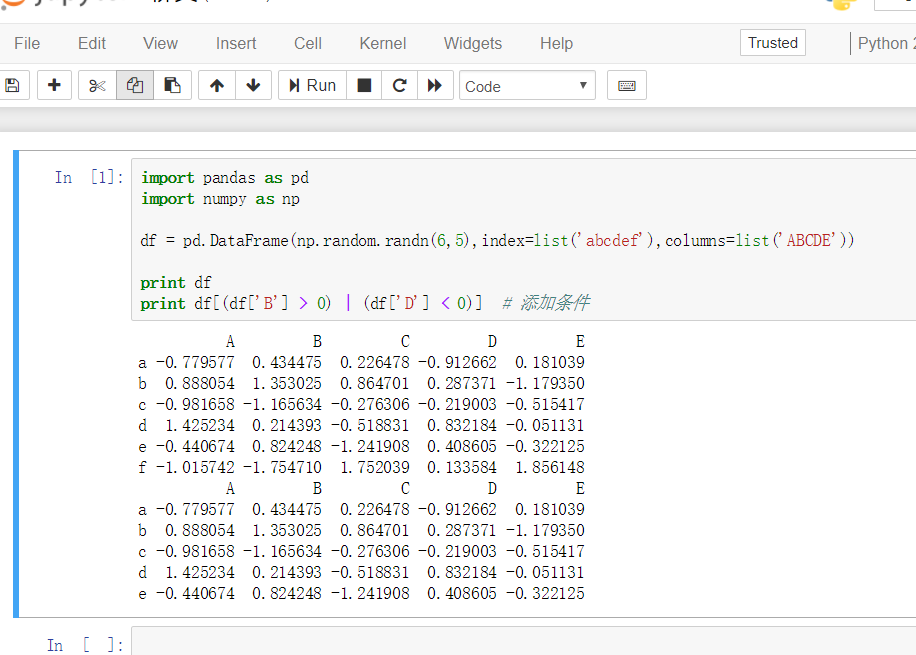1 pandas numpy模块
首先安装搭建好jupyter notebook,运行成功后的截图如下:
安装使用步骤(PS:确定Python安装路径和安装路径里面Scripts文件夹路径已经配置到环境变量中去,即pip所在路径已经配置到环境变量中去):
//以下说明是在Windows环境下 //安装 pip install jupyter notebook //不出意外即可安装成功 //然后在Scripts文件夹里面即可看到安装后的jupyter notebook相关配置文件 在CMD中输入jupyter notebook即可在默认浏览器中打开jupyter notebook网页编辑页面

推荐资料:
2 peewee模块
使用peewee连接mysql数据库,进行增删查改操作语句示例。原文链接

增 单条增加 方法1 StudentsInfo.create(student_name='amos', student_no=880) 方法2 StudentsInfo.insert(student_name='lucy', student_no=881).execute() 等同于insert into student_info (student_name, student_no) values ('lee',882) 多条增加 方法1 data_source = [ {'student_name': 'lance', 'student_no': 883}, {'student_name': 'john', 'student_no': 884}, # ... ] for data_dict in data_source: StudentsInfo.create(**data_dict) 方法2(这个方法会快很多) data_source = [ {'student_name': 'jason', 'student_no': 886}, {'student_name': 'tom', 'student_no': 887}, # ... ] with database.atomic(): for data_dict in data_source: StudentsInfo.create(**data_dict) 方法3(最快的方法) data_source = [ {'student_name': 'hom', 'student_no': 888}, {'student_name': 'baby', 'student_no': 889}, # ... ] with database.atomic(): StudentsInfo.insert_many(data_source).execute() 如果数据量太大或许你需要分开处理,比如一次处理100条: data_source = [ {'student_name': 'hom', 'student_no': 888}, {'student_name': 'baby', 'student_no': 889}, # ... ] with database.atomic(): for idx in range(0,len(data_source),100): StudentsInfo.insert_many(data_source[idx:idx+100]).execute() 删 单条删除 st = StudentsInfo.get(student_name='hom') st.delete_instance() 等同于DELETE from student_info where student_name = 'hom' 多条删除 StudentsInfo.delete().where(StudentsInfo.student_no < 883).execute() 等同于DELETE from student_info where student_no < 883 改 方法1指定数据 StudentsInfo.update(student_no=890).where(StudentsInfo.student_name == 'baby').execute() 方法2依据原有数据自动更新 StudentsInfo.update(student_no=StudentsInfo.student_no + 1).where(StudentsInfo.student_name == 'baby').execute() 方法3 多字段更新 StudentsInfo.update(student_no=890,student_name='lady').where(StudentsInfo.student_name == 'baby').execute() 查 1. 一般查询 st1 = StudentsInfo.select() 查询所有的记录并获取他们 for i in st1: print i.student_no, i.student_name 2. 单条查询 st2 = StudentsInfo.get(StudentsInfo.student_no == 883) print st2.student_no, st2.student_name 对比1和2个区别 先获取他们的类型 print type(st1) == > <class 'peewee.SelectQuery'> Print type(st2) == > <class 'createDB.StudentsInfo'> st1是’SelectQuery'类型需要使用for循环逐条获取,而st2本身就是一个实例的对象可以直接获取它的属性 3. 查询部分字段 st3 = StudentsInfo.select(StudentsInfo.student_no) 4. 有条件查询 st4 = StudentsInfo.select().where(StudentsInfo.student_no == 883) 5. 随机查询 需要先引入fn from peewee import fn st5 = StudentsInfo.select().order_by(fn.Random()).limit(2) 6. 排序查询 正序 st6 = StudentsInfo.select().order_by(StudentsInfo.student_no.asc()) 反序 st6 = StudentsInfo.select().order_by(StudentsInfo.student_no.desc()) 7. Not in组合查询 简单举例,现有学生信息表student_info学生姓名student_name和学号student_no,学生成绩表score_table学号student_no和分数score st7 = StudentsInfo.select(StudentsInfo.student_no).where(StudentsInfo.student_no > 880) sc = StudentsScore.select().where(StudentsScore.student_no.not_in(st7)) 8. 模糊查询 比如想要查询学生名字包含’ba’的学生以及学号 %符号就相当于sql里的like st8 = StudentsInfo.select().where(StudentsInfo.student_name % '%ba%') for i in st8: print i.student_no,i.student_name 纯手打,多谢支持。
